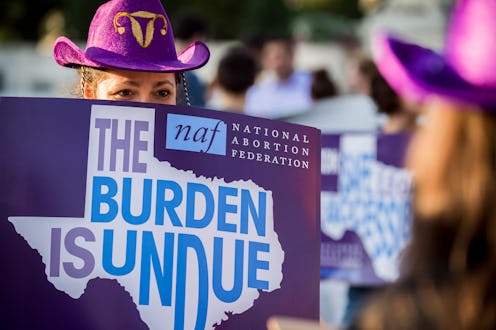Today's long-awaited Supreme Court ruling in the case of Whole Woman's Health v. Hellerstedt — which found the court striking down a set of Texas abortion restrictions that would have closed down over half of the state's clinics that provide abortions — was a major win for abortion rights in America. The court made a profound statement against not only this law, but abortion restrictions of a similar nature across the country —Justice Stephen G. Breyer said, in his opinion, that the restrictions placed on abortion providers in the Texas law “provide few if any health benefits for women, pose a substantial obstacle to women seeking abortions and [constitute] a, ‘undue burden’ on their constitutional right to do so."
And Justice Ruth Bader Ginsberg made an even stronger statement, in a separate piece joining Breyer's opinion, noting that abortion laws like those that were struck down serve no reasonable legal purpose: “So long as this court adheres to Roe v. Wade and Planned Parenthood of Southeastenr Pa. v. Casey, targeted regulation of abortion providers laws like HB2 that do little or nothing for health bur rather strew impediments to abortion cannot survive judicial inspection.” Any way you slice it, today is a watershed moment in the struggle for reproductive justice in this country.
But while this ruling will most likely have extremely positive ramifications for reproductive rights all over the land, it doesn't solve every problem women have when trying to access abortion — not by a long shot. While TRAP laws (it stands for "Targeted Regulation of Abortion Providers") like this one, which pile on unnecessary regulations of abortion clinics that most can't afford to keep up with, are one way that anti-abortion activists restrict women's access, there are still many other barriers that often stand in the way of women who seek abortions and other reproductive care — especially women of color and women with fewer financial resources.
La'Tasha D. Mayes, founder and executive director of New Voices for Reproductive Justice, explained to Bustle that many issues regarding reproductive health access remain, even in light of this decision: "Abortion is one of many intersection issues of concern to the Reproductive Justice Movement. Medicaid coverage of abortion, contraceptive access and equity, birth justice and maternal healthcare, discrimination in healthcare provision particularly to people of color and LGBTQIA+ people, gender-based individual, community or state violence, comprehensive sex education and more will not be improved by this ruling. "
So what can we do to help people who still face significant barriers to getting the care they need? One option is to support abortion funds — grassroots groups from around the country that connect women who want abortions with money, transportation or temporary housing, and other resources they need in order to make it happen. Mayes says, "Readers can support or start an abortion fund in their community through National Network of Abortion Funds. Black women can join the network of policy advocates on Capitol Hill through In Our Own Voice: National Black Women's Reproductive Justice Agenda and be proactive in creating what we need in our communities. We cannot wait for institutions of oppression to provide us tools for our own liberation."
And now that this major hurdle has been struck down, those of us who are passionate about reproductive rights can devote even more energy to focusing on grassroots organizing. Mayes also notes that we can "[a]ctively support organizations like New Voices to continue the fight for Reproductive Justice with your generous donations of money to expand our community organizing, time as a leader and/or informed ally to advocate for visionary policymaking and daily efforts in your personal circles of influence to dismantle race and gender oppression for culture change."
So while today is obviously a time to celebrate an amazing victory, and look towards a brighter future, it's also not a time to forget the many people whose ability to access reproductive healthcare is still not certain.
